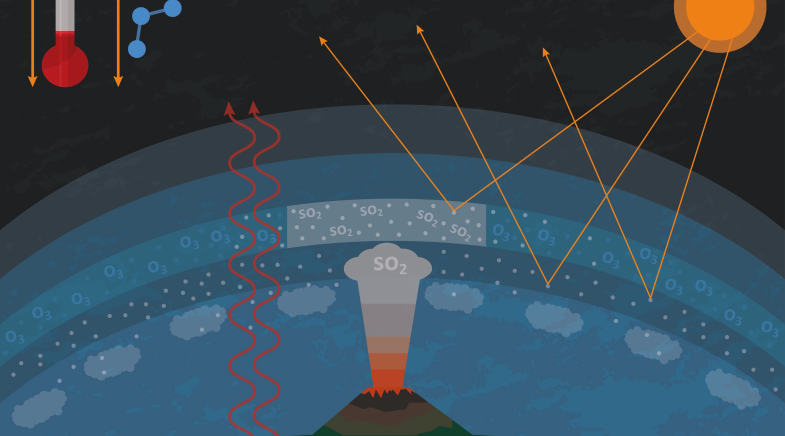'Geoengineering masks climate change problem'
-
- from Shaastra :: vol 01 edition 03 :: Sep - Oct 2021

Climate scientist G. Bala on the pros and cons of geoengineering, and why we need to treat this emerging area with caution despite the possibilities.
The most recent report of the Intergovernmental Panel on Climate Change (IPCC) addresses a contentious issue: carbon dioxide removal (CDR) from the atmosphere to limit global warming. However, the IPCC's Sixth Assessment Report, released in August, largely ignores another related but contentious issue: solar geoengineering. It states that solar geoengineering has the potential to offset global warming, but it does not say much more. In fact, IPCC didn't even call the technique geoengineering; it preferred the phrase 'solar radiation modification'. In spite of the IPCC's reluctance to discuss geoengineering thoroughly, scientists have been researching the topic for some time now. Solar geoengineering, or reducing global temperatures by reducing the solar radiation that comes to the Earth, is accepted by scientists as an effective way to curb global warming. But the method comes with a variety of side effects that are not easy to understand. Govindasamy Bala, Professor at the Centre for Atmospheric and Oceanic Sciences, at the Indian Institute of Science, Bengaluru, and a contributor to the IPCC report, explains the potential of solar geoengineering and its risks.
Excerpts from an interview he gave T.V. Padma:
The IPCC Working Group (WG) I report mentions geoengineering as a potential option for mitigating climate change. At what stage do you think we will need to use geoengineering?
The recent IPCC WG1 report highlights the recent unprecedented rapid changes in the climate system caused by human activities such as fossil fuel burning and land-use changes. It also cautions that the magnitude of these changes will amplify with additional emissions and the consequent additional warming in the future. Originally, geoengineering was envisioned as an option to cool the planet rapidly in case of a planetary emergency such as the breaking of ice sheets or successive crop failures due to heat stress. However, geoengineering in recent years is being suggested as a short-term option to avoid the overshoot of warming above thresholds such as 1.5° or 2° Celsius.
"Solar geoengineering has the potential to cool the planet in a few years by about 1-4°C, while conventional mitigation (emission reduction) would take decades to cool the system by similar amounts."
Interestingly, as per its mandate, the IPCC does not give any policy prescription regarding what governments should do to address climate change. In a similar manner, the IPCC WG1 makes only a scientific assessment of the effectiveness and side effects of solar geoengineering to the various components of the climate system. It does not give any prescription on if, when and how geoengineering should be deployed. I believe that is for governments to negotiate and reach an agreement.
What are the geoengineering options available, in theory?
The main idea is to reflect sunlight to space by an amount equal to the infrared (IR) radiation trapped by greenhouse gases. In theory, there are several options: placing mirrors in space; injecting highly reflective aerosol particles into the stratosphere; injecting sea salt aerosols into low-level marine stratocumulus clouds to enhance their reflectivity; painting roofs of buildings in urban areas white; bioengineering to make crop leaves more reflective; creating microbubbles at the ocean surface to reflect more sunlight; adding reflective material to increase the reflectivity of the world's desert regions, and so on. Dissipation of high-level cirrus clouds to allow more IR radiation to escape to space has also been proposed. Although the last option is strictly not a solar geoengineering option, recent IPCC reports have included this in the portfolio of solar geoengineering options. Among all the proposed options, stratospheric aerosol geoengineering is the most studied approach. The effectiveness and side effects of these various options have been studied using climate models in the past 20 years. However, the technology needed for any of these options to work at the required planetary scale has not been developed.
What are the potential benefits and risks of geoengineering?
The immediate benefit is the rapid reduction in global warming. Solar geoengineering has the potential to cool the planet in a few years by about 1-4° C, while conventional mitigation (emission reduction) would take decades to cool the system by similar amounts. The associated benefits are the reduction in the intensity and frequency of heatwaves, extreme rainfall, tropical cyclones, floods and droughts. A reversal in the decline of the Arctic Sea ice extent is also expected. However, reversing the rise in sea levels and the retreat of glaciers and ice sheets will take time. Ocean acidification will not be reversed as it is caused by elevated levels of CO2 in the atmosphere and not by global warming.
The offset of climate change by geoengineering would be imperfect: climate change in every region and every season on Earth would not be offset when global warming is fully offset. One of the potential risks from all geoengineering options is the reduction or shift in rainfall patterns. This could be particularly severe in the case of more localised options such as increasing the reflectivity of marine clouds and ocean and land surface. Thus, there would be some winners and some losers. Injecting aerosols into the stratosphere could cause depletion of stratospheric ozone, which could lead to more lethal UV radiation reaching the Earth's surface. This could be detrimental to human health and crop productivity. The recovery of the Antarctic ozone hole may be delayed.
We should also note that geoengineering is a "mask" to the climate change problem. Geoengineering does not address the root cause of the problem, which is the increase in greenhouse gases. If the mask is ever removed abruptly for some reason, we would suddenly be exposed to a world with very large amounts of greenhouse gases. Such an abrupt and sustained termination of geoengineering would result in an extremely rapid rate of increase in temperature that would far exceed the rate of climate change without SRM (solar radiation management). Water cycle changes could also be abrupt. Such an extremely rapid rate of climate change caused by a "termination shock" could put severe stress on human and natural systems.
"(With geoengineering) there will always be some winners and some losers, which could cause tension among nations."
What is the status of research worldwide?
How much of it do we understand?
Advance in geoengineering research is at present limited mostly to indoor climate modelling activity. This activity is at a very advanced stage now because scientists at major climate modelling centres around the world have spent more than a decade on this simulation science, and models have also become more sophisticated. Field experiments have been proposed in the past, but they have not taken off on a big scale because of resistance from environmental groups. Without large-scale field experiments, it would be challenging to assess the benefits and risks of geoengineering.
Interestingly, in the case of stratospheric aerosol geoengineering and marine cloud brightening, there are natural analogues, and we can learn a lot from them. Major volcanic eruptions provide natural analogues for stratospheric aerosol geoengineering, and ship tracks seen in satellite images in the marine cloud regimes provide the analogue for marine cloud brightening. Major volcanic eruptions inject the gas SO2 into the stratosphere, which gets oxidised to form highly reflective sulfate aerosols. The most recent major volcanic eruption, at Mount Pinatubo in 1991, caused a global mean cooling of about 0.5° C in 1992. Coordinated observations of major volcanic eruptions in the future could help us understand the benefits and risks of stratospheric aerosol geoengineering. Similarly, studying ship tracks in the marine environment would help us gain insights into the marine cloud brightening option. Most of the current scientific uncertainty about the effectiveness of geoengineering stems from our incomplete understanding of aerosol-cloud-radiation interactions. These interactions are also the major sources of uncertainty in our quantification of global warming using models.
How long do you think it will take to scale up geoengineering technology to planetary-level intervention if shown to be useful?
Most research has focused on the injection of stratospheric aerosols. This option has the potential to offset the global mean warming either fully or partially in the future. However, the technology for lifting the aerosols to a height of 20-25km does not exist today. Note that we are talking about injecting millions of tonnes of aerosols into the stratosphere using thousands of aircraft each year. Cost estimates are available. It is estimated that the technology for aircraft specifically built for this purpose could be developed in 10-20 years, and the cost of operating a large-scale deployment would be in the order of $10 billion per year. This is much cheaper when compared to the hundreds of billions of dollars per year that are required for conventional mitigation options.
What are the implications for India if other countries implement some form of geoengineering?
It is likely that the severe impacts of climate change such as heatwaves, intense cyclones, extreme rainfall, floods, droughts and a sea-level rise in vulnerable tropical countries such as India could be reduced or averted if solar geoengineering is deployed. However, as discussed earlier, geoengineering could alter the regional precipitation patterns and cause a reduction in the Indian monsoon rainfall - with severe consequences for water resources and agriculture in India. Plant productivity and crop yields could also be reduced because of a slight decrease in the sunlight that reaches the surface. Indeed, some studies have shown a likely decrease in crop productivity in India if geoengineering is implemented.

Further, climate modelling studies have shown that if aerosols are injected into the stratosphere in the northern hemisphere, Indian and North African monsoon rainfall would decrease, but these monsoon regions would see an increase in rainfall if the same aerosols are injected in the southern hemisphere. The opposite response is simulated by models for monsoon regions in the southern hemisphere. Thus, there would always be some winners and some losers, which could cause tension among nations. To sum up, I would say that the current unknowns are too large. For now, I would suggest more research to understand the benefits and risks of geoengineering for India as there has been little investment in this emerging research area in the country.
Have a
story idea?
Tell us.
Do you have a recent research paper or an idea for a science/technology-themed article that you'd like to tell us about?
GET IN TOUCH














